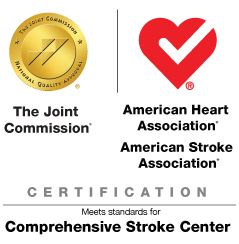Browse this page
Welcome to the Comprehensive Stroke Center at MedStar Georgetown University Hospital
MedStar Georgetown University Hospital Comprehensive Stroke Center expansive services ensure that we can treat and provide excellent quality of care to the most complex stroke patients around the clock. We have dedicated, specially-trained clinicians available at any time of day or night, including board-certified vascular neurologists. Having their expertise readily available ensures our patients are receiving the care they need which provides better long term outcomes for stroke survivors.
The effects of stroke can be devastating. Life-long disability or death, however, is no longer a given due to new procedures and treatments. At MedStar Georgetown, experts work together to ensure patients receive the care they need, whether it’s urgent care, brain surgery, the latest technologies for diagnostics and treatment, cutting-edge clinical trials or rehabilitation.
Our services
Our integrated, in-house emergency stroke team is staffed 24 hours a day, seven days a week by stroke neurologists, neuro-interventional radiologists, cerebrovascular neurosurgeons, and other specialists as needed.
Because time is of the essence in treating stroke, our emergency department teams are trained to provide rapid, excellent care by making stroke a priority. In addition, we have a rapid response team that evaluates patients and sets in motion specific procedures to diagnose the cause of the stroke.
The stroke team provides care utilizing cutting-edge technologies (such as brain perfusion imaging) and treatments (such as endovascular throbectomy - or clot removal). The MedSTAR Transport system—ready to retrieve a patient within a 250-mile radius by air or ambulance—assures wide and rapid access to this level of emergency care.
Stroke treatment care
Every minute the brain is deprived of blood flow, more brain cells die. The earlier the blood flow is restored, the less likely a stroke patient will have permanent damage. Neuro Critical Care is essential to control intracranial pressure as well as blood pressure, breathing, and heart function.
Not only must physicians diagnose if someone has just had a stroke, they must also determine the type of stroke treatment as options vary, based on whether the stroke is hemorrhagic or ischemic, as well as on the stroke’s severity.
Immediate stroke treatment
Physicians will order a variety of diagnostic tests to determine the location and extent of brain injury, as well as evaluate the condition of the arteries in your neck and brain that supply blood to your brain.
- Ischemic stroke: The most effective medicine for the treatment of ischemic stroke is the FDA-approved drug, t-PA (tissue plasminogen activator). Administered intravenously, it works with your body's enzymes to dissolve blood clots. This highly-effective stroke treatment must be given within 4.5 hours of the onset of stroke, so it imperative to seek medical care immediately. For certain ischemic strokes where t-PA cannot be administered or is ineffective, endovascular clot removal may be an option. Learn more about Ischemic stroke.
- Hemorrhagic stroke: The best and safest way to remove blood from the brain after a hemorrhage and minimize damage to the brain may include minimally invasive surgical removal of the clot (through small catheters or tubes), clot busting medication to dissolve the clot, and medications to minimize swelling caused by the clot. For hemorrhages caused by aneurysms and arteriovenous malformations, a skilled neuro-interventionist or neurosurgeon can repair or block the vessels to prevent further bleeding. Many of these procedures can be performed through a minimally invasive technique. Learn more about Hemorrhagic stroke.
Advanced endovascular treatment
Beyond providing the highest level of emergency stroke intervention, neuro-interventionists are helping to shape new standards of care for cerebrovascular patients through endovascular approaches. These consist of minimally invasive surgical treatments for cerebrovascular disease and include:
- Acute stroke thrombectomy: new technology that allows removal of clots in the brain through small catheters, or tubes
- Brain aneurysm treatment: using coils, stents or flow-diverters (such as the pipeline embolization device)
- Brain arteriovenous malformation/fistula (AVM/F) treatment: using liquid embolic agents (such as Onyx or n-BCA)
- Tumor embolization: using polyvinyl alcohol (PVA) particles
- Carotid (or intra-cranial) stenosis treatment: using micro-balloons and stents
Surgical treatment
Certain strokes originating from carotid artery disease, brain aneurysms, AVMs, and hypertensive hemorrhages benefit greatly from surgical interventions. Using the most advanced surgical and microsurgical techniques available today, MedStar Georgetown neurosurgeons perform:
- Surgical clipping of complex (ruptured and unruptured) brain aneurysms
- Surgical resection of arteriovenous malformations/fistulas
- CyberKnife radiation, which delivers concentrated beams of radiation from multiple positions while sparing healthy tissue
- Carotid stenosis treatment using a surgery to remove the plaque causing the narrowing
Neurorehabilitation
Our multidisciplinary group of experienced physical therapists, occupational therapists, speech therapists, and neurorehabilitation physicians provide comprehensive patient-centered rehabilitation therapies designed to maximize stroke recovery.Using minimally invasive techniques to treat stroke and aneurysm: Ask Dr. Andrew Stemer

Andrew Stemer, MD is a neurologist, a neuro-interventional radiologist and director of the Stroke Program at MedStar Georgetown University Hospital. Here he answers questions about symptoms and treatments for strokes and aneurysms using minimally invasive endovascular techniques.
Visiting Us
Additional information
Timeframe: CY 2023 (January - December 2023)
When viewing this data, the higher number is better.
Stroke national performance measures
| Stroke performance measures | Compliance rate* |
|---|---|
| VTE prophylaxis by hospital day 2 | 99% |
| Anti-thrombotic Medication at hospital discharge | 100% |
| Anticoagulation therapy prescribed at hospital discharge for patients with atrial fibrillation or atrial flutter | 100% |
| Antithrombotic medication by end of hospital day number 2 | 100% |
| Stroke education provided | 95% |
| Assessed for rehabilitation services | 99% |
*National Target Benchmark is above 85% compliance
Additional stroke performance measures for procedures and interventions at MedStar Georgetown University Hospital (2023):
- Serious complication rates for carotid endarterectomy and carotid stenting are better than the national benchmark (<6% for symptomatic ICA stenosis and <3% for asymptomatic ICA stenosis).
- Serious complication rates for diagnostic cerebral angiogram are better than the national benchmark (<1%).










